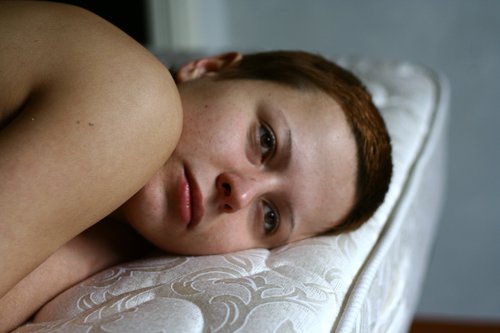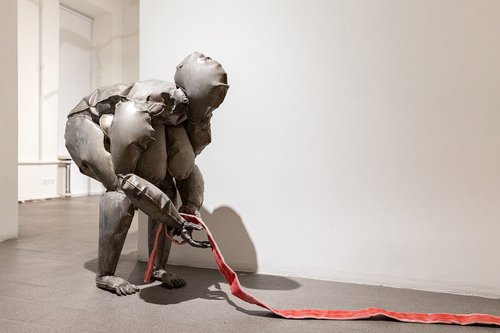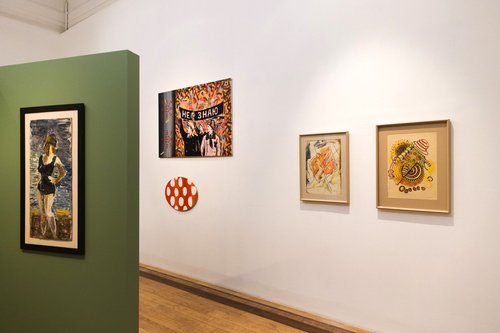Artist Anya Zholud Has Passed Away

Portrait of Anya Zholud. Courtesy of Grindchinhall Gallery
Among the most famous Russian artists of her generation, 43-year-old sculptor and painter Anya Zholud has died. During her tragically short career she developed a minimalistic yet heart-piercing visual language that, once seen, could not be forgotten.
The emptiness that had always been the subject of study for Anya Zholud (b. 1981), whose work was included in the main exhibition of the 53rd Venice Biennale and who won the prestigious Russian Innovation award, was taken to its absolute in her last project – Paragraph at the PA gallery in Moscow. Visitors to the show no longer encountered the contours of things and objects, as if cast in metal, but torn bundles of rods, abandoned to fate amongst a gaping white emptiness. There may be no form, but there is content. Screaming with loneliness and with naked tension. Zholud had been living in this state for the last fifteen years since the death of her husband Vitaly Skvortsov, one of the founders of the Expo-88 Gallery.
Zholud lived in a flat near the house that her husband gave her in 2006, in the small village of Arinino near Gzhel on the outskirts of Moscow. She transformed the 30-hectare territory into an art space, where there was a gallery (or rather, a non-gallery, as Anya put it) called Roadside, a workshop and a residence for guests. She rarely ventured into Moscow. As PA Gallery stated, “in April, artist Anya Zholud ended up in hospital in a serious condition and stopped communicating with anyone”. She had been suffering from mental health problems for a long time, and although Vitaly had helped her to maintain her balance; after his death, Anya Zholud regularly wound up in clinics and increasingly lost touch with reality.
The creative path of this graduate of the St Petersburg Art College named after N.K. Roerich and the St Petersburg State Academy of Art and Industry named after A.L. Stieglitz began in Moscow in 2001, when Anna Zholudkovskaya came to Expo-88 gallery, which was then located at house number 1 on Zabelina Street and showed her drawings. She was met by Skvortsov's partner Elena Yakovleva who first believed in this unknown, young artist from St Petersburg. Within a few years, Anya Zholud became a phenomenon on the Moscow art scene. Vitaly, who initially had doubts about the young talent, later did a great deal for her career and moral equilibrium.
In 2005–2006, Zholud found what became her signature style of emptied things. The first objects made from reinforcement bars, devoid of materiality, were shown at the exhibition ‘Museum of Me’ at the Art-Strelka gallery in 2007. “Previously I painted proper pictures, that is, pictures corresponding to a realistic picture of the world, then not quite proper ones, now very improper ones. Not so long ago I was engaged in creating an ‘improper world’ in the real world, that is, translating flat, painterly images into real volumes. Now these volumes are taking the form of what in artistic terminology is called by the indecent word ‘installation’”, Zholud wrote at the time.
In the same year, 2007, the artist was nominated for the Innovation award, the following year for the Kandinsky Prize, and in 2009 she took part in the main exhibition of the Venice Biennale with the project ‘Communications’, which was shown in the Arsenal. Aesthetically, it was close to the ‘Paragraph’ exhibition, which became Zholud's last. From the white wall there, too, protruded torn bundles of wires. Only they stretched towards the light – light boxes on which they “drew” mysterious abstractions, which highlighted even more clearly, as she wrote, “human-to-human connections”, “connection nodes”, “points of contact”, “the beginning and continuation of infinity”, “the visible and invisible, the special and the accidental”, “the real and the apparent”, “the actual and the imagined”. The wires appeared at the entrance to the space, disappeared into the walls, floor and ceiling, permeated the entire Arsenal, became invisible, and reappeared at the exit. At the Paragraph exhibition, the wires seem to have completely lost their interconnections.
The years 2008–2009 became the peak of Anya Zholud's creative career; at that time she was only 28. Her solo exhibition took place at the State Russian Museum, from which, in essence, emerged the landmark project for the Venice Biennale. At the same time, she transformed her St Petersburg flat into an exhibition hall called ‘Object in the Neighbourhood’, which opened with the project ‘House Plant’, later shown in its full version at Aidan Salakhova's (b. 1964) gallery at Winzavod.
At that time, Alexander Borovsky, head of the department of modern trends at the Russian Museum, wrote about her: “Anya Zholud achieved recognition very quickly. She emerged several years ago, at the peak of the glamourization of the domestic mainstream. In this context, Zholud's wire-and-reinforcement objects, with traces of welding scale, acquired an almost polemical character. These were not projections of residential or office interiors, although they contained certain didactics of assembly and operation manuals. These were projections of proper life, without excesses, presentations and consciousness-expanding stimulants. The timeliness of Zholud's message was appreciated: the black bread of rusty reinforcement and school geometry in an era of excess.”
The exhibition at Winzavod confirmed that Zholud did not invent her objects but lived with them, in them. Many remembered her exactly like this – walking her dog amongst the metal contours of house plants in concrete pots amongst protruding rusty rods. In form, what Zholud did was pure minimalism, which referenced Moscow romantic conceptualism. In fact – a familiar story about the ‘ordinary person’ in sad circumstances.
After Vitaly Skvortsov died from a heart attack, Zholud continued to work on potential exhibitions, but now with a feeling of inertia. “After his departure, Anya ended up in a psychiatric clinic for the first time, where I visited her, although mental problems had existed before, but together with Vitaly they somehow managed to cope with them. My daughter and I visited her at 'Roadside'; it was difficult to communicate, you could feel the tension in her”, gallerist Elena Yakovleva told The Art Newspaper Russia.
In 2012, she received the Innovation award. Conceptual asceticism continued to live in her: at the ‘Last Exhibition’ at Gridchinhall, she exchanged her works –from paintings with teapots and broken tiles to fragments of iron constructions from ‘Communications’ – for paint, cement, iron pieces, firewood. Shortly before that, she had just as easily given away all her paintings and works on paper to anyone who wanted them at the St Petersburg Era Foundation at the exhibition ‘Free to a Good Home’.
In her last years, Anya Zholud, whose works can be found in the Hermitage, the State Tretyakov Gallery, the State Russian Museum, the Moscow Museum of Modern Art, and the Museum of Nonconformist Art, lived, almost like her house plants, in a modest one-room flat in the Electroizolyator settlement, not far from ‘Roadside’, and wrote: “Not to leave the house and not to open the curtains, not to call anyone over the phone – this seemed to become a principle of my existence.”
This article was first published in Russian on the website of The Art Newspaper Russia on 6 June, 2025.

















